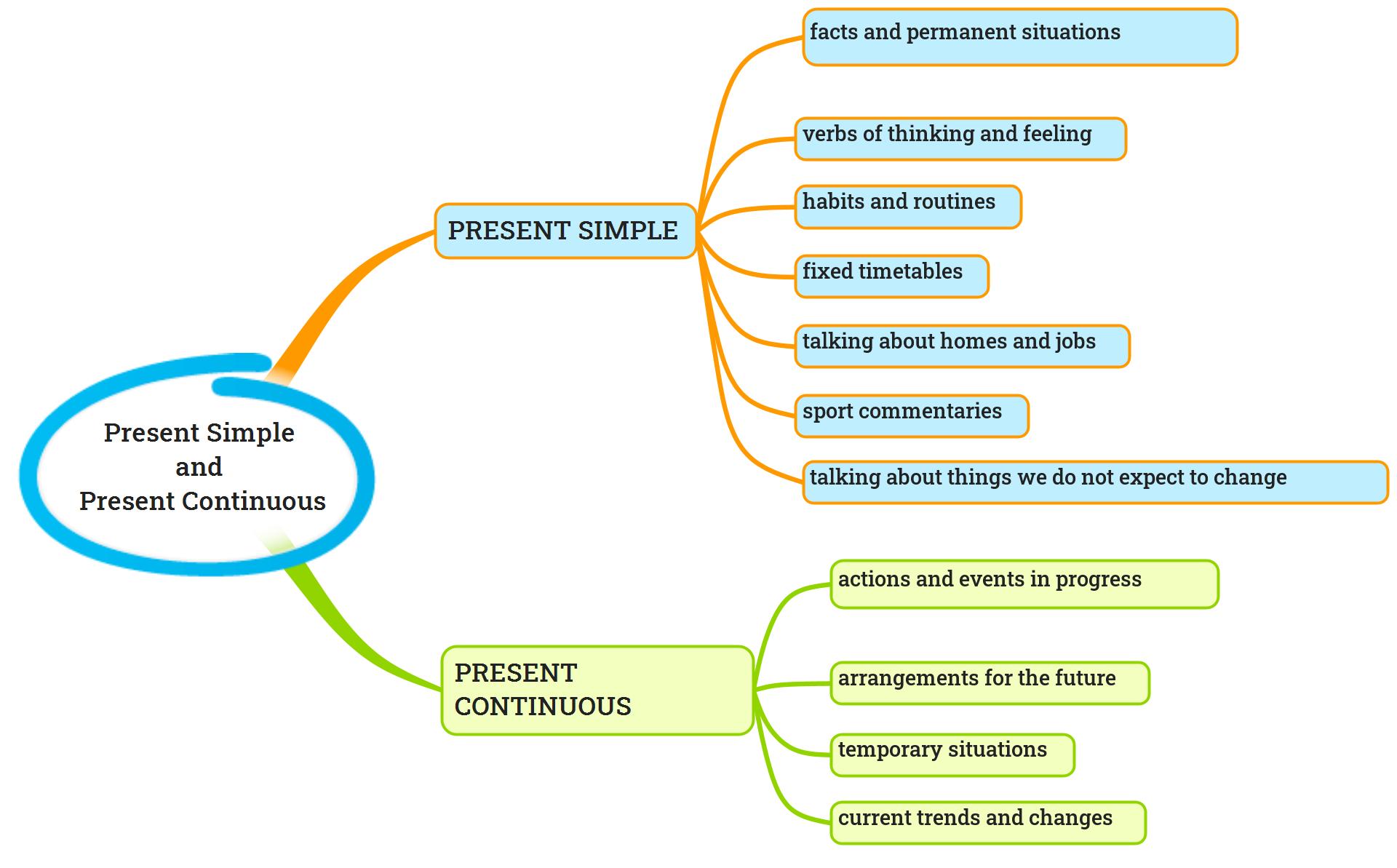


Uses of Present Simple and Present Continuous Tenses
THE BLUE TREE
Tests & Quizzes

CEFR A2
Pre-Intermediate
TEST YOUR ENGLISH

The key to mastering the English tenses lies in understanding what we use them for.
Do the tests below and check how well you know what we use the Present Simple and Present Continuous tenses for.
If you get more than 70 % of correct answers you will receive a beautiful certificate.
part one
Decide if uses a) to k) are usually associated with the Present Simple or Present Continuous tenses.
part two
Now assign the correct use of Present Simple and Present Continuous to the examples below.

A report on progress

Learn Present Continuous Tense

Present Perfect or Past Simple
Bardzo mi przykro, ale lekcje na platformie The Blue Tree działają jedynie na komputerze lub tablecie.
Do zobaczenia na większym ekranie 🙂
Zespół The Blue Tree
back to HOME > Learning English > English Grammar >
THE BLUE TREE
English Grammar

CEFR B1
Intermediate
warm up
Answer the questions below.
- How many ways are there to talk about the present in English?
- Do you think having more grammar tenses is an advantage or a nuisance?
- How important is it for you to speak grammatically correct?
part one
STUDY SECTION
The Fellowship of the Ring
Read and listen to the dialogue below. Focus on the way Gandalf explains the difference between Past Simple and Present Perfect tenses and the examples they discuss.
Frodo, Sam, and Gandalf sat around the flickering flames of a small bonfire, enjoying a moment of respite from their long journey. As they sipped their cups of tea, Sam spoke up.
“Mr Gandalf, sir, can you explain the difference between Present Perfect Tense and Past Simple Tense?” he asked, looking earnestly at the wizard.
Gandalf raised an eyebrow in surprise. “That’s an unexpected question, Samwise. But I suppose we have time for a little lesson, don’t we?”
He cleared his throat and began, “The Past Simple Tense is used to describe a completed action that happened in the past, such as ‘I walked to the store yesterday.’ On the other hand, the Present Perfect Tense is used to describe an action that started in the past and continues up until the present, or to describe a past action that has a present result. For example, ‘I have walked to the store many times.'”
Frodo furrowed his brow in confusion. “But why not just use the Past Simple for everything?”
“Ah, well, that’s a good question Frodo,” Gandalf said, taking a sip of his own tea. “Using the Present Perfect Tense can sometimes convey a sense of continuity or repetition, which the Past Simple cannot. It can also suggest a connection between the past and present, which can be useful in certain contexts.”
“I see,” Sam said, nodding thoughtfully. “So it’s like the difference between saying ‘I ate breakfast’ and ‘I have eaten breakfast every day this week’?”
“Exactly Sam,” Gandalf said, smiling at the hobbit. “You’ve got it!”
Gimli, who had been sitting nearby but not actively participating in the conversation, spoke up. “Well, I for one am glad I don’t have to worry about any of that. Dwarf language is much simpler!”
Everyone laughed, and the conversation turned to lighter topics as they enjoyed the warmth of the bonfire and each other’s company.
As the conversation continued around the bonfire, Boromir spoke up. “I’m not sure I quite understand. Could you give us some more examples?”
“Of course Boromir,” Gandalf said. “Let me think…Here’s another example of the Past Simple Tense: ‘I saw a movie last night.’ The action happened and was completed in the past. And for the Present Perfect Tense, we could say, ‘I have seen that movie before.’ The action happened at some point in the past, but the result is still relevant now.”
Legolas, who had been sitting quietly up until this point, added his own example. “In elvish we might say, ‘I have hunted in these woods for many years.’ It implies that the hunting happened at different times in the past, but the person is still hunting in the present.”
Pippin chimed in next. “So, the Present Perfect Tense is like talking about the past in the present?”
“In a way, yes,” Gandalf said. “It’s a useful tool for linking the past and the present. But it can also be used to describe a past action that has an effect in the present. For example, ‘I have lost my keys’ – the action happened in the past, but the person is still affected by it in the present.”
Merry looked up from his tea. “But what about irregular verbs? They don’t follow the normal past tense pattern, do they?”
“Ah, you’re right Merry,” Gandalf said. “Irregular verbs can be a bit tricky. For example, the past tense of ‘go’ is ‘went,’ not ‘goed.’ And the Present Perfect Tense of ‘eat’ is ‘have eaten,’ not ‘have eated.'”
The conversation continued on like this for some time, with each member of the team contributing their own questions and examples. As they talked, the fire burned low and the night grew dark around them. But the warmth of their friendship and the joy of learning together kept them all together, unified in their quest to destroy the One Ring.
CAN YOU TELL THE DIFFERENCE
Read the pair of sentences. Do you understand why some sentences were built using Present Perfect and others using Past Simple?
PAIR 1
- 1A Frodo, you didn’t eat a thing yesterday.
- 1B No, Sam. And I haven’t eaten anything today, either. The burden of the ring is weighing heavily on me.
PAIR 2
- 2A Legolas, how long were you in the healing houses of Rivendell?
- 2B Legolas replied, “I have been in and out of the healing houses for centuries. My Elvish blood may make me immortal, but it doesn’t make me immune to injury.”
PAIR 3
- 3A Gandalf, I travelled around Europe last year.
- 3B “I’ve never even been abroad,” replied Boromir. “My duties to Gondor have always kept me close to home.”
PAIR 4
- 4A Gimli, I passed my driving test in 1987.
- 4B “That’s nothing,” says Gimli. “Driving carts and wagons has been in our blood for generations. We have been learning it since we were able to walk.”
PAIR 5
- 5A Aragorn, I had a shower before breakfast.
- 5B “I can’t go out yet,” Arwen said with a laugh. “I’ve just had a bath. My hair is still wet, and I don’t want to catch a cold.”
Comments
All A sentences use Past Simple for:
- finished time
- completed actions
All B sentences use Present Perfect for:
- past action with a present effect
- unfinished time
- actions completed a short time before the present
part two
watch the video
WHAT’S THE DIFFERENCE
Watch the first part of the video. Jack is exmplaining the main difference between Past Simple and Present Perfect. Makes notes about the points he is making.
Comprehension
Explain the difference in meaning between these sentences:
- I’ve been to Madrid four times.
- My grandma never went to Madrid.
- Paul has never been to Madrid.
- I’ve told her a few times this week.
- She’s been in London four times in total.
- He’s called me twice today.
- In 2006 I went to Madrid with some friends.
PRACTISE WITH JACK
Watch the second part of the video. Practise the difference between Past Simple and Present Perfect with Jack.
Note down what Jack says about the difference between British English and American English usage of these tenses.
part three
PRACTICE
TIME EXPRESSIONS
Jack told us that there are some expressions that we use with Past Simple and others that we use with Present Perfect.
Play this Multidecker game to learn more about these expressions.
CHOOSE THE TENSE
Now play this game in which you need to decide if the verb should be in Past Simple (did), Present Simple (I do), or Present Perfect (I have done).
TRANSLATE THIS SENTENCE
Finally, play this Multidecker game. Here you need to think how you would translate these sentences from Polish into English. Click on the card to see the answer.
SUMMARY
Past Simple:
- Actions or events that happened and ended in the past
- A series of completed actions in the past
- Time expressions that refer to a specific past time
Present Perfect:
- Actions that started in the past and continue up to the present
- Actions that happened at an unspecified time in the past
- Recently completed actions or events with a connection to the present
- Time expressions that refer to a period of time that includes the present






